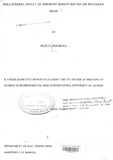| dc.description.abstract | The rapid rate of industrial and urban growth in Kenya with the resultant pollution of aquatic systems provided stimulus to the present study on the pollutional effects of brewery effluent on Ruiruaka river.The river, passing through the northern suburbs of the Nairobi city, offers an ideal situation of industrial pollution on a natural watercourse. Rising about 20 km west of Nairobi, it flows eastward through Limuru, Karura forest, Ruaraka (where it encounters the brewery effluent) and finally drains into the Nairobi river at the Oandora area. The pysico-chemical of a selected reach within Ruiruaka river (the Ruaraka reach) was investigated' during the period 30 th October 1990 to 20th February, 1991.
Temperature in the river did not seem be affected with the entry of the brewery effluent. pH values of 7.1 and 7.3 were recorded in the river before and after the brewery effluent entry respectively. Other parameters monitored before and after the brewery effluent were; 800516 - 106 mg/I, COO 34 - 216 mg/I, DO 4.9 - 2.7 mq/l, TOS 127 -
388 mg/I and TSS 41 - 238 mg/I.
Concentrations of the organic parameters analyzed showed low levels before brewery effluent and exceedingly high levels downstream of the brewery plant, an indication of a polluting source. A generalized inverse relationship was found to exist between con centrations of parameters monitored and discharge before brewery effluent but ceased
'to exist after the brewery effluent discharge. This was as a result of polluting nature of the effluent.
The Streeter - Phelps O~-BOO mathematical model was tested on the Ruiruaka river
with the data collected during the study period. Calculated DO values were seen to compare with the observed DO values at a station which was 155 metres from the last effluent discharge channel. Combining the waste to discharge via one outlet made the river anaerobic at times thus making it worse than it was when receiving segregated effluent while pretreating to the proposed effluent discharge standards presented Ruiruaka river as a good source of water supply for domestic or industrial purposes.
The results of the present study will provide baseline data to reinforce the need for industries to pretreat their effluent before discharge into natural water courses.
It is concluded that the brewery plant has induced significant changes in the chemical characteristics of the Ruiruaka river and that the pollution load has caused consider able biodegradation on the river
It is therefore recommended that control at the source of pollution for the brewery plant and other polluting agents along the course and a check on the soil conservation in the cultivated areas in the river catchment will greatly improve the quality of the river water. Pollution law enforcement would help a great deal in solving this pollution problem. | en |

